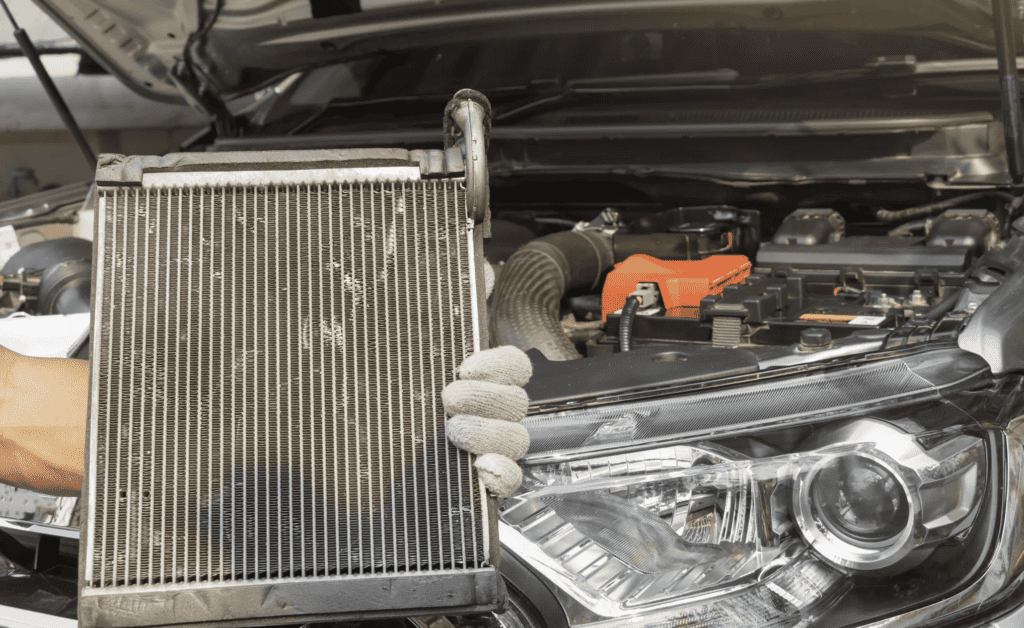No one hits the road anticipating their radiator to falter, but it’s the unpredictability that keeps us on our toes. The radiator, the unsung hero under your hood, maintains your engine’s temperature. When it goes awry, you can expect a domino effect of problems, turning a smooth ride into motorist mayhem. This underscores the necessity of understanding and recognizing the early warning signs.
The Heat is On: Recognizing Radiator Failure Signs
• Temperature Troubles: One of the most direct indicators. If that temperature gauge keeps creeping upwards, it’s a clear sign something’s amiss. A constantly fluctuating temperature reading can indicate that the coolant isn’t circulating properly.
• Visible Vexations: Witnessing a steamy performance under your hood? That’s not your car applauding your driving. Steam indicates the coolant is boiling over, likely because it’s not being efficiently cooled by the radiator. If you spot bright green, orange, or pink fluid pooling beneath your car, that’s the coolant – and it’s supposed to be inside your radiator, not on the ground.
• The Scented Signals: A failing radiator might release a somewhat sweet, yet sharp aroma. It’s the smell of the coolant, which shouldn’t be escaping. If the radiator starts to overheat, it might produce a burnt smell, indicating that not just the radiator, but potentially other engine components, are getting too hot.
• Audible Alarms: Strange noises coming from the engine area, like bubbling or gurgling, hint at possible air pockets or boiling coolant – both are red flags. When the radiator is under stress or leaking, it might let out a hissing sound, akin to steam escaping.
• Fluid Fluctuations: If you’re regularly topping up your coolant, it’s disappearing somewhere, and that’s a cause for concern. If the radiator is failing, coolant can mix with the engine oil, turning it into a sludgy substance. If your oil dipstick shows a milky residue, it’s time for immediate action.
In essence, your vehicle is quite the chatterbox when things go south. And while the radiator might be but one component, it certainly knows how to raise an alarm. The key lies in listening, observing, and acting promptly.

From a Sizzle to a Burst: What Leads Radiators to Fail
Every part of a vehicle has a lifespan, and the radiator is no exception. Over time, the continuous cycles of heating and cooling, combined with the stress of keeping the engine at optimal temperatures, start to leave their mark. Age, without doubt, is a common reason for radiator failures. But it isn’t always just the passage of time that takes its toll. The daily wear and tear, coupled with prolonged use, can weaken the radiator’s core, reducing its efficiency.
Radiators don’t always degrade on their own. External factors can hasten their journey to malfunction. A faulty thermostat, for instance, can prevent the coolant from circulating properly, leading to overheating. Hoses, which channel the coolant, might get compromised, either due to blockages or external damage. Speaking of external damages, a simple fender bender or even debris from the road can damage the radiator. And let’s not forget about the coolant itself. It’s not just about having coolant, but having the right kind. The wrong type or mixture, or even a low level, can put undue stress on the radiator. Such seemingly trivial missteps can quickly escalate, culminating in the dreaded radiator burst.
Roadside Reactions: Immediate Steps After Radiator Failure
• Initial Observations: Keep an eye on temperature gauges; if they’re spiking, it’s a clear signal. Steam or smoke emerging from the hood indicates overheating.
• Immediate Actions: Engage hazard lights, ensuring you’re visible to other motorists. Pull over to a safe spot, away from traffic. If on a highway, try to reach an exit or a shoulder.
• Cooling Down: Turn off the vehicle immediately to prevent further damage. Allow ample time for the engine to cool down before attempting any checks.
• Inspection and Caution: Look for visible leaks or damages without opening the hood. If safe to open the hood, check if coolant levels have significantly dropped. Never attempt to open the radiator cap right after stopping; built-up pressure can lead to scalding hot coolant spraying out. Always wait for the engine to cool down sufficiently.
Quick Fixes: Temporary Solutions for Radiator Problems
A Glimmer of Hope in Dire Situations: We’ve all been there – an unexpected radiator issue in the most inconvenient of times. It’s tempting to look for a fast solution that can get us back on the road, if only for a short distance. For those fleeting moments of crisis, there are indeed quick fixes available. Minor leaks, for instance, don’t always require immediate professional intervention. Various products in the market can seal these tiny holes, providing a makeshift remedy until you can get a more permanent solution.
The Makeshift Coolant Solution: A radiator without coolant is like a fish out of water, quite literally. In cases where you’re caught off-guard and don’t have any coolant at hand, water can come to the rescue. It acts as a temporary substitute, helping to regulate the engine temperature for a short while. However, this isn’t a free pass to keep driving indefinitely. Such quick fixes buy you time, nothing more. As soon as possible, you’ll want to make a pit stop at a professional mechanic to ensure no lurking issues go unnoticed.
To Drive or Not to Drive: Understanding the Risks of an Overheating Radiator
Picture this, you’re driving, and suddenly, the temperature gauge starts edging towards the red zone, signaling an overheating radiator. But home or your destination is just a few kilometers away. Tempting to push through, right? It feels like a challenge where you weigh the pros of reaching your destination sooner against the cons of potential vehicle damage. But, as the adage goes, it’s better to be safe than sorry. The dangers of driving with an overheating radiator are vast and, more often than not, outweigh the brief convenience.
On the surface, it might seem that the only issue is the radiator getting a tad too warm. But the repercussions run deep. When a radiator overheats, it isn’t just about the radiator itself. The engine, which relies heavily on the cooling system to function optimally, is at grave risk. Overheating can lead to warped engine parts, blown head gaskets, and even complete engine failure. And when you compare the cost of fixing or replacing an engine to that of addressing a radiator problem, the latter is a fraction of the former. It’s a high-stakes gamble where the odds aren’t in your favor. Best to pull over, cool down, and call for professional help.
Repair or Replace: Evaluating Radiator Damage and Solutions
As with any ailment, the first step towards a solution is a proper diagnosis. The symptoms of a radiator issue might range from overheating to visible leaks. While these signs provide clues, they don’t always reveal the entire picture. A small leak, for example, might be patched up or sealed, providing a relatively easy and cost-effective fix. Blockages or clogs, too, can often be addressed through a professional cleaning process, restoring the radiator’s efficiency.
However, not all radiator issues are that forgiving. Sometimes, the problem lies deep within – like a compromised radiator core. When the core, essentially the heart of the radiator, is damaged, it often spells the end of the road for that particular unit. Here, patch-ups won’t do. A complete replacement becomes inevitable. But making this call isn’t always straightforward. This is where professional expertise becomes invaluable. Consulting with a seasoned mechanic can offer clarity, ensuring you choose the most effective and economical solution. After all, radiators are pivotal to your vehicle’s health, and decisions regarding their care shouldn’t be taken lightly.

Breaking Down the Bills: Cost Estimations for Radiator Repairs and Replacements
Variability Factors
• Vehicle Specifics: Whether you’re cruising in a compact car or maneuvering a mammoth SUV, the type of vehicle you own plays a part in radiator repair costs. A high-end luxury or classic vehicle can have bespoke radiator components that can bump up the price tag. On the flip side, for widely driven models, parts can be more economical, ranging from $100-$400.
• Extent of Damage: A simple leak might be a relatively easy fix, perhaps costing you anywhere from $50-$200. However, if the heart of your radiator – its core – is damaged, brace yourself for a replacement, which could set you back between $300-$900.
• Labor Costs: City slickers might pay a premium for radiator repairs compared to those in the countryside. While you might shell out between $80-$185 per hour in urban areas, rural rates could be slightly more forgiving. Remember, an expert mechanic might have higher rates, but the assurance of quality work could save you future headaches and costs.
• Parts Required: Going for OEM parts? While they might promise longevity and compatibility, they come with a price range of $100-$500, depending on your vehicle. Aftermarket alternatives can be more wallet-friendly, often between $50-$350, but ensure they’re from a reputable brand.
Cost Dynamics
• Minor Repairs: Tightening a loose bolt or swapping out a tired hose won’t have you breaking the bank, with costs often hovering between $20-$150. Addressing these small hiccups promptly can prevent a full-blown financial storm later.
• Major Overhauls: When your radiator’s in deep water, extensive work might be needed. This can involve detailed inspections, part replacements, and labor-intensive tasks. If associated systems are affected, your bill could soar from $400 to even $1,500, depending on the complexity.
• Preventative Measures: Just like health check-ups, your radiator too can benefit from regular inspections. Spending $50-$100 on a routine check can be a bargain when you consider it could stave off future repair costs in the thousands.
Investment Perspective
• Immediate Cost vs. Long-term Savings: While doling out $150 on a repair might sting, think of it as insurance against a potential $1,000 expense later. Keeping your radiator in top shape prevents engine mishaps, safeguarding you from astronomical repair bills.
• Radiator’s Significance: It’s not just a component; it’s the guardian of your engine’s health. Spending on its upkeep, whether it’s $50 or $500, is an investment in your vehicle’s longevity and optimal performance.
Navigating Radiator Roadblocks – The Journey to Radiator Resilience
Our journey on the road isn’t always smooth sailing. However, understanding our vehicle, especially the mighty radiator, prepares us for potential pitfalls. Regular maintenance is the golden ticket to a resilient radiator. And if ever in doubt, remember professionals like Uchanics are just a call away, ensuring you’re never truly stranded in Canada. Safe travels!
